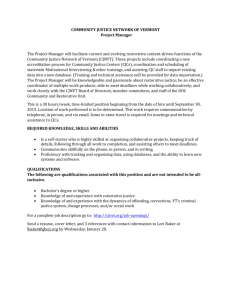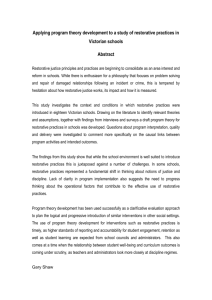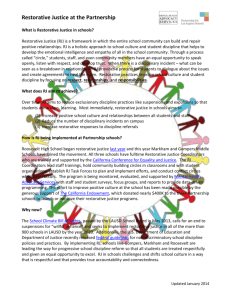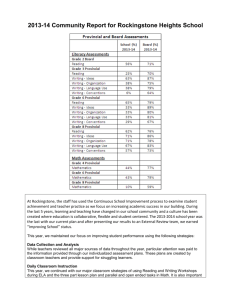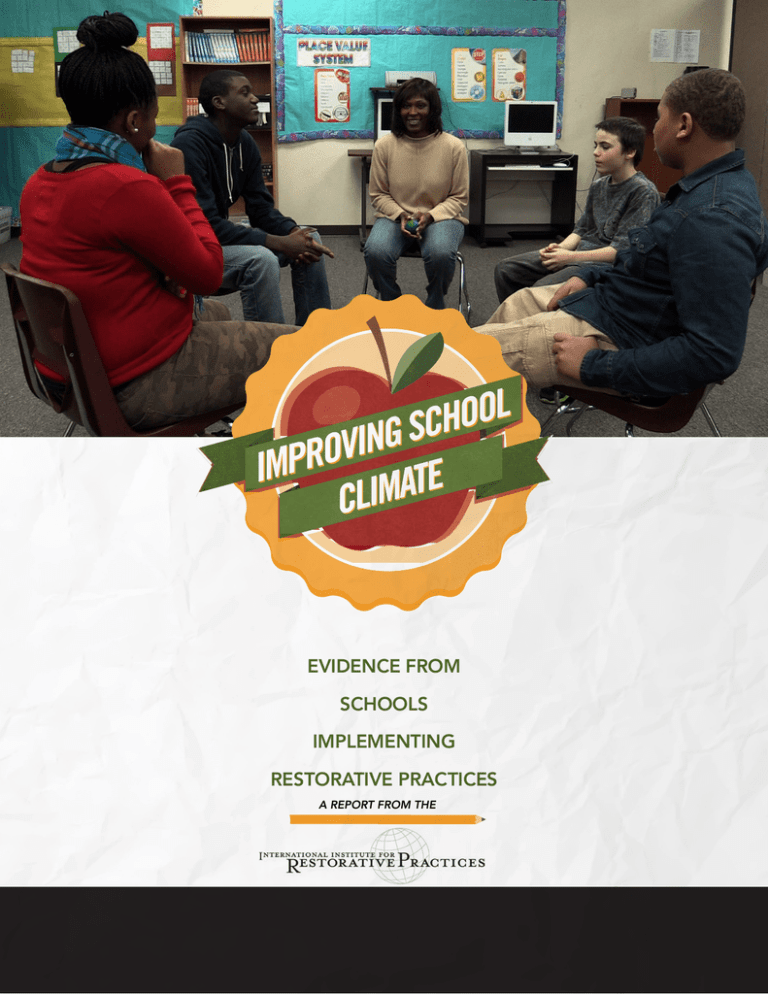
EVIDENCE FROM
SCHOOLS
IMPLEMENTING
RESTORATIVE PRACTICES
A REPORT FROM THE
A
s the International Institute for Restorative Practices SaferSanerSchools
Whole-School Change Program is launched in more and more schools
across the country, we are seeing many positive results from restorative
practices implementation. The research graphs in this fact sheet show that these
outcomes include significant reductions in misbehavior and punitive discipline,
in grades K-12. We are also seeing improved teacher-student relationships in
classrooms with a high level of restorative practices implementation, and that this
improvement tends to narrow the “racial-discipline gap,” a concern in schools
nationwide.
What’s more, restorative practices have truly become part of the national education conversation. With the U.S. Federal Government issuing guidelines that
explicitly recommend restorative practices as an alternative to harmful, racially biased zero-tolerance policies, school districts from coast to coast have incorporated
these practices into their discipline principles.
And restorative practices aren’t just for discipline; they are also essential to
high-quality teaching and learning. These restorative principles apply to learners
of all ages and abilities: that learning builds social capital and a sense of community; that students feel connected to the group and responsible for each other’s
learning; that students feel empowered to come up with their own learning activities.
Restorative practices are the focus of current research in schools nationwide: by
Johns Hopkins University and Diplomas Now, supported by the Atlantic Philanthropies; and by RAND Corporation, supported by the National Institutes of Mental Health and the U.S. Department of Justice. These projects are exploring a wide
range of outcomes, including restorative practices’ effects on graduation rates,
social competency, academic achievement, alcohol abuse and bullying.
Learn more at:
SaferSaner Schools
Whole-School Change Through Restorative Practices
www.safersanerschools.org
International Institute for Restorative Practices
www.iirp.edu
Improving School Climate
A publication of the International Institute for Restorative Practices
P.O. Box 229, Bethlehem, PA 18016 USA
(610) 807-9221
Copyright 2014 © IIRP Graduate School. All rights reserved.
3 million students are
suspended each year.
IIRP
WHOLE-SCHOOL
(Advancement Project, July 2013)
CHANGE
KEEPING STUDENTS IN SCHOOL WHERE THEY CAN LEARN.
Reduced Suspensions
1
2
103
Hampstead Hill (Pre-K–8), Baltimore, MD
71
85
47
50
88
84
52
41
31
61%
28
2008– 2009– 2010– 2011– 2012– 2013–
2009 2010 2011 2012 2013 2014
9
Overall
decrease
from 2008
Freedom High School, Bethlehem, PA
91%
2008– 2009– 2010– 2011– 2012– 2013–
2009 2010 2011 2012 2013 2014
3
Overall
decrease
from 2008
Glenmount School (K–8), Baltimore, MD
69%
64%
67%
77%
Reduced
Serious
Infractions
Reduced Number
of Students with
Multiple Suspensions
Reduced
Suspensions
Reduced Number
of Students with
Multiple Suspensions
2010–2011: 29
2012–2013: 9
2010–2011: 330
2012–2013: 120
2012–2013: 76
2013–2014: 25
2012–2013: 13
2013–2014: 3
CHANGING BEHAVIORS
The restorative environment at CSF Buxmont (IIRP model
schools for at-risk youth) enhances the effectiveness of Aggression Replacement Training®, a cognitive-behavioral intervention
program. Outcomes data compiled by the EPISCenter at Penn
State University, collected from 67 at-risk youth at CSF Buxmont
who completed the Aggression Replacement Training® program
from January 2012 through April 2014, showed higher rates of
reductions in aggression and cognitive distortions, as well as
improvements in social skills, when compared with that of
youth at other Pennsylvania Commission on Crime and Delinquency (PCCD)-funded Aggression Replacement Training® sites.
26 %
20%
Reduced
Aggression
Improved
Social Skills
11 pts higher than
average outcomes
4 pts higher than
average outcomes
3
NARROWING THE RACIAL GAP
- African-American students are 3 times more likely to be suspended than white students.
- Just 1 suspension doubles a student’s risk of dropping out.
(Advancement Project, July 2013)
R
equity in school discipline, thereby narrowing the racial discipline gap, according to a study
led by Anne Gregory of Rutgers University. Classrooms with a high level of restorative practices
implementation (High RP) had fewer disciplinary referrals for defiance and misconduct compared
to classrooms with a low level of implementation (Low RP), over the 2011–2012 school year.
In addition, as shown in the graph below, the gap in the average
number of misconduct/defiance referrals between Asian/White
9.13
Afri
and Latino/African American students was narrower
can
-Am
eric
in High RP classrooms than in Low RP classrooms.
an
/Lat
ino
1.69
White/Asi
an
2.92
0.77
LOW RP
HIGH RP
Reduced Racial Gap in Defiance
and Misconduct Referrals
Graph reprinted by permission from Taylor & Francis, LLC
NEW SCHOOL POLICIES
Coast to coast, more and more districts are adopting restorative policies.
T
he U.S. Federal Government issued new guidelines recommending that schools revise their
discipline policies to move away from zero tolerance policies, which exclude large numbers
of students with suspensions and expulsions, often for minor infractions. Instead the guidelines
recommend the use of methods such as restorative practices, which foster positive school climates.
“Restorative practices builds
community to reduce misbehavior
and provides a way to restore
oneself to that community should
misconduct take place.”
— Dr. Linda Lane,
Superintendent, Pittsburgh
Public Schools
“We are 100 percent committed to deepening
and extending our practies of positive tiered
behavioral interventions and alternatives to
suspension in order to increase instructional
time and reduce racial disparities.”
— Richard Carranza, Superintendent, San
Francisco United School District
“More students are making the right
choices, and our princiapls, teachers
and school staff members are providing
the right supports and guidance. We are
very proud of what our school
communities continue to accomplish.”
— William Hite, Jr., Superintendent,
School District of Philadelphia
4


